
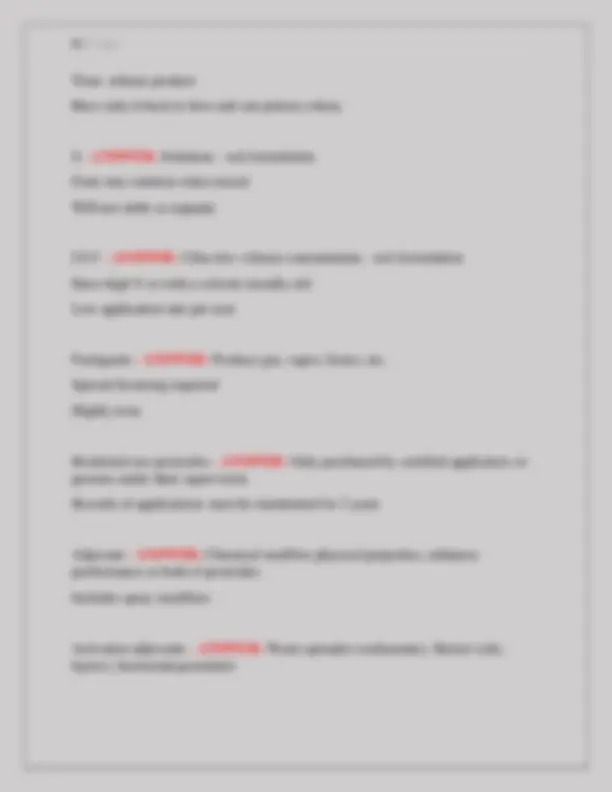
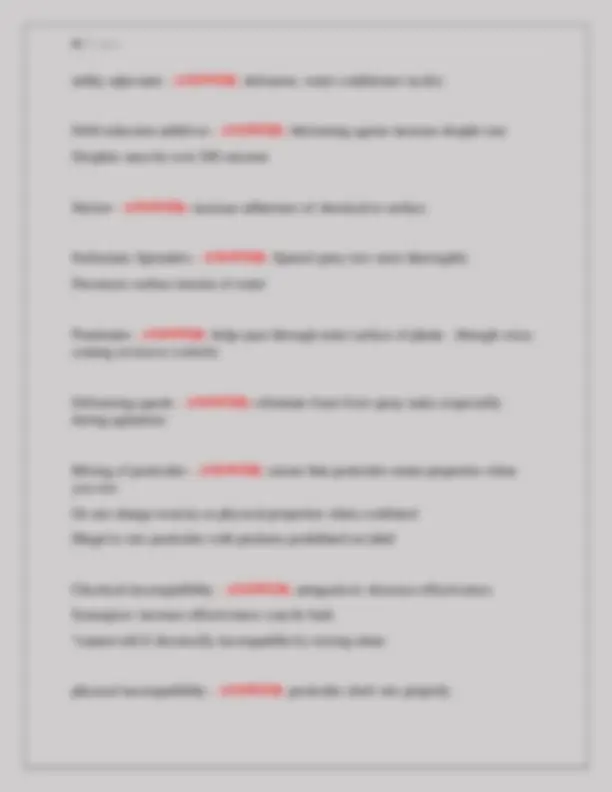
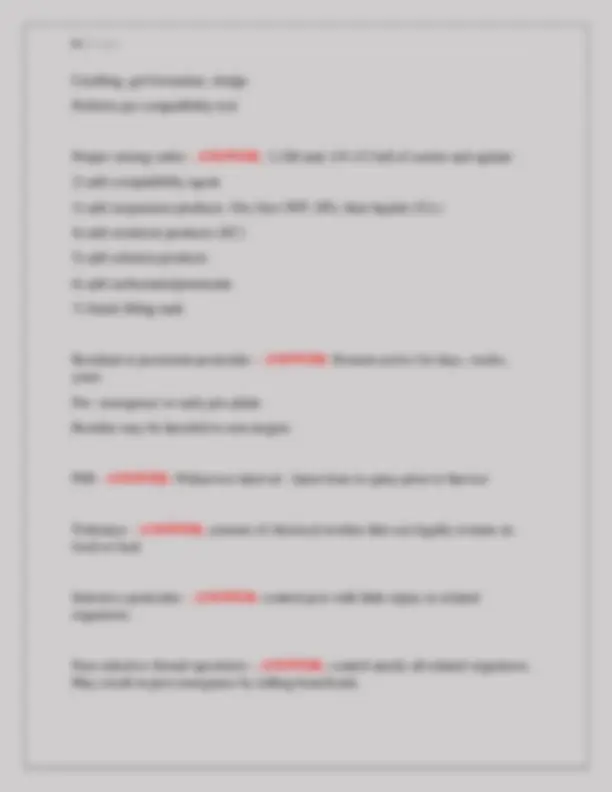
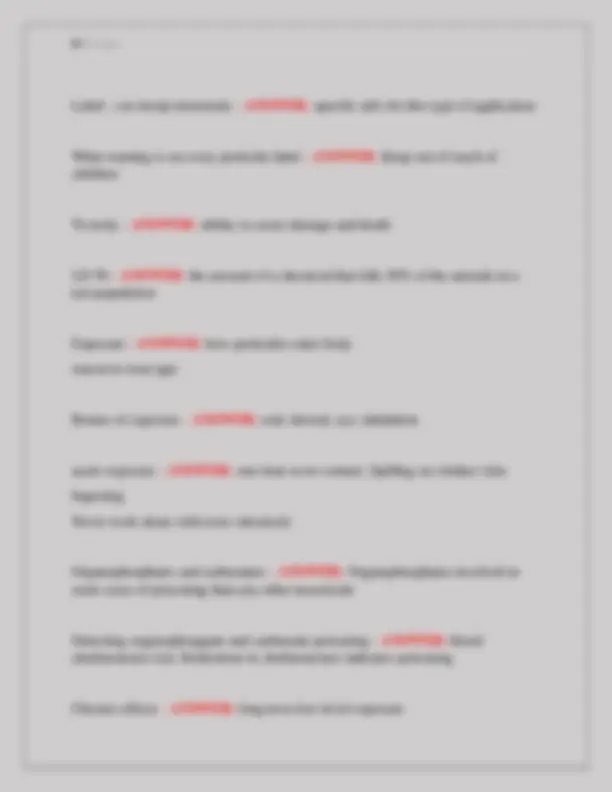
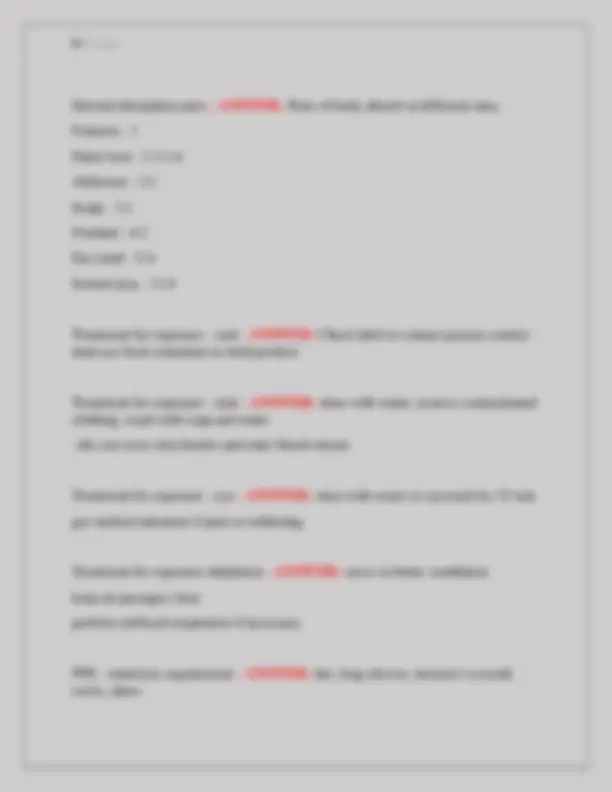
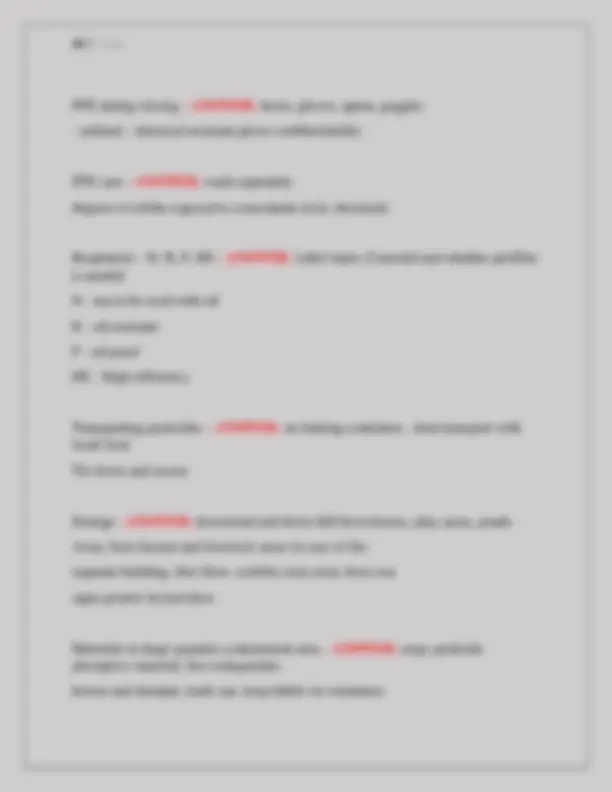
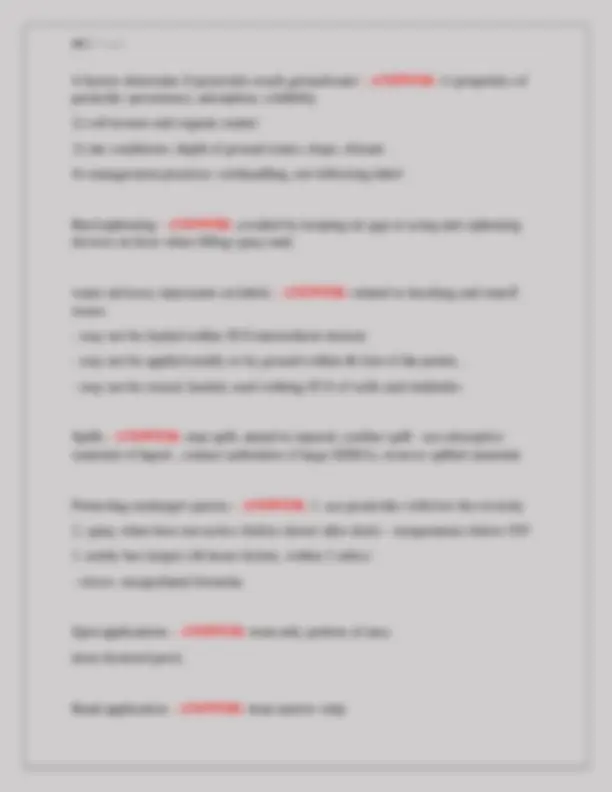
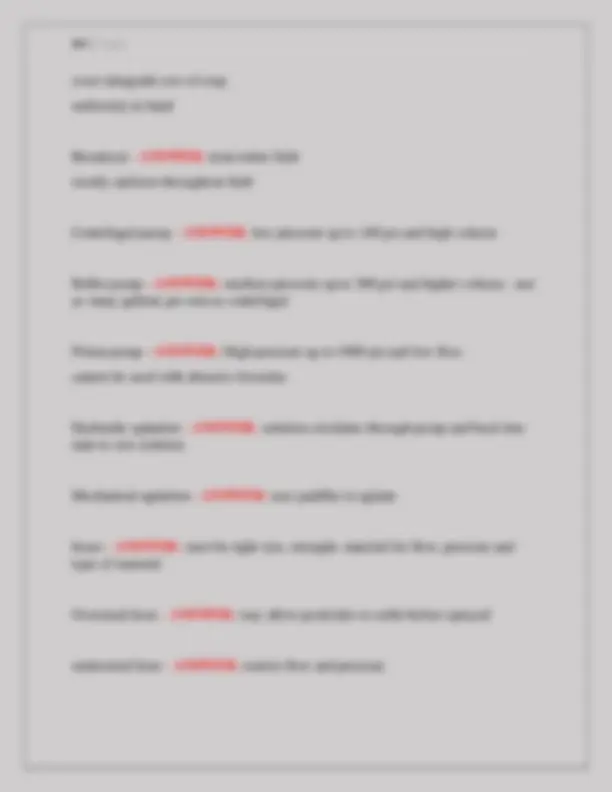
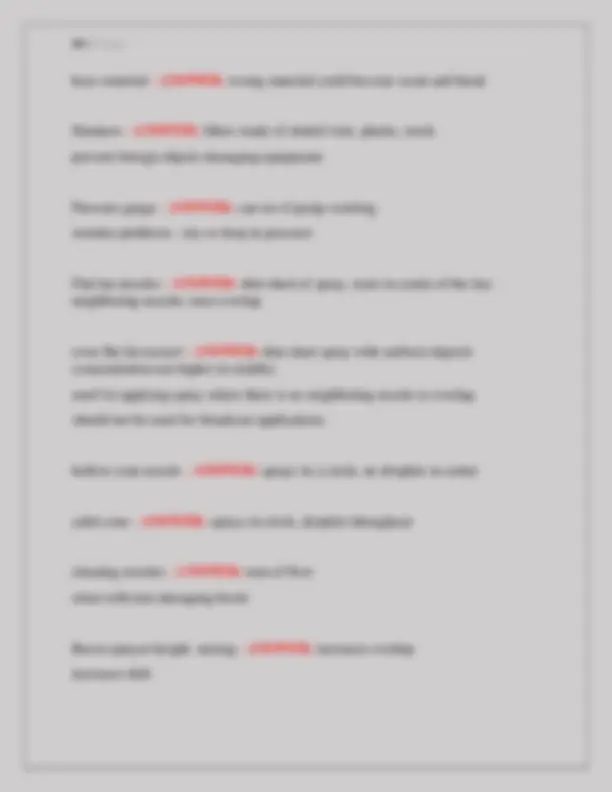
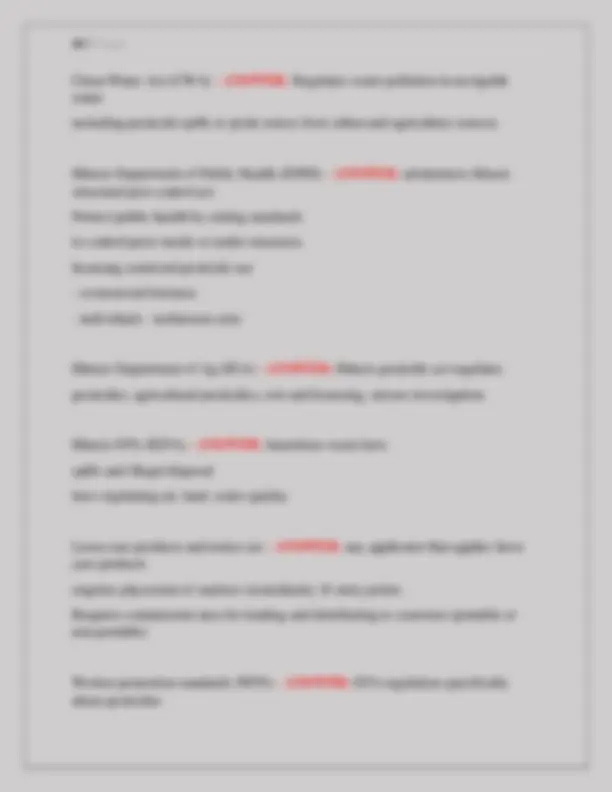
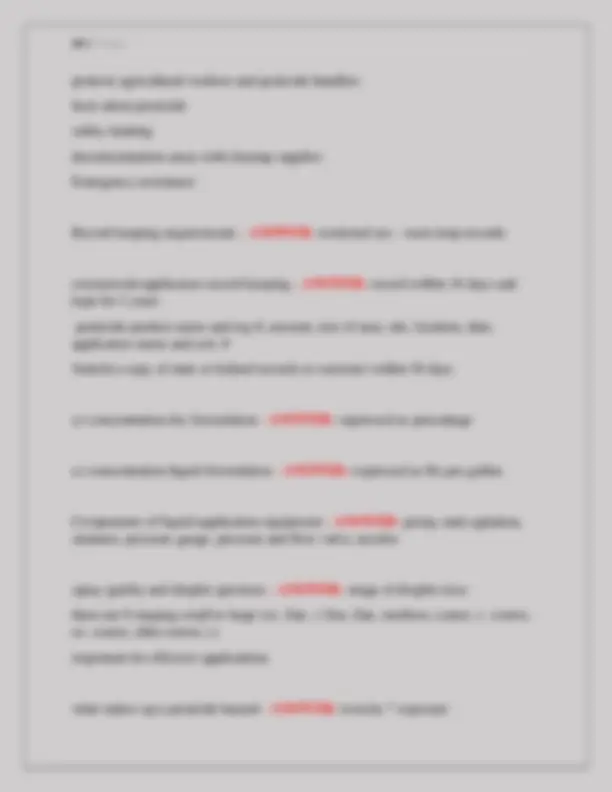
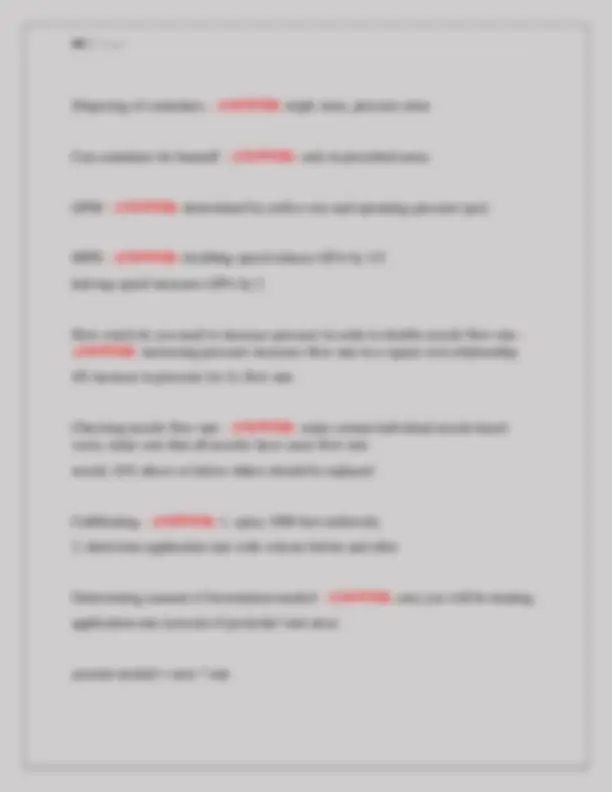
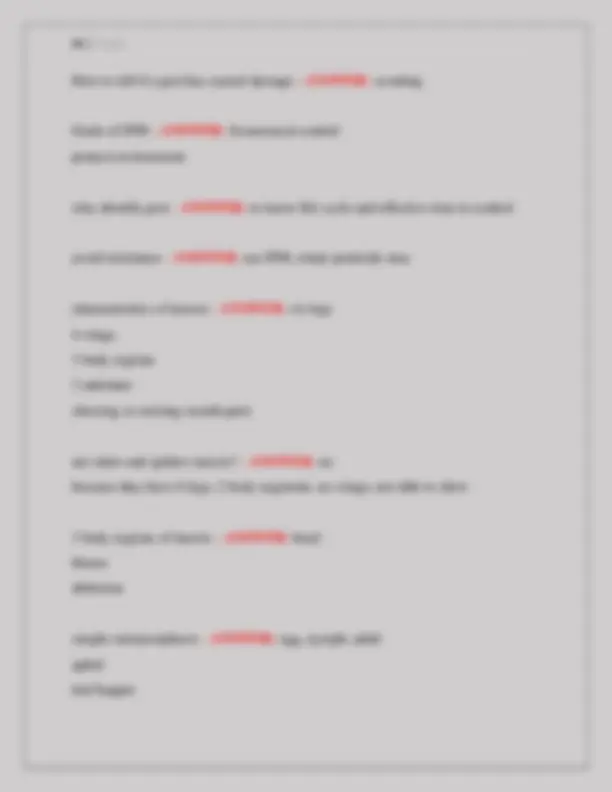
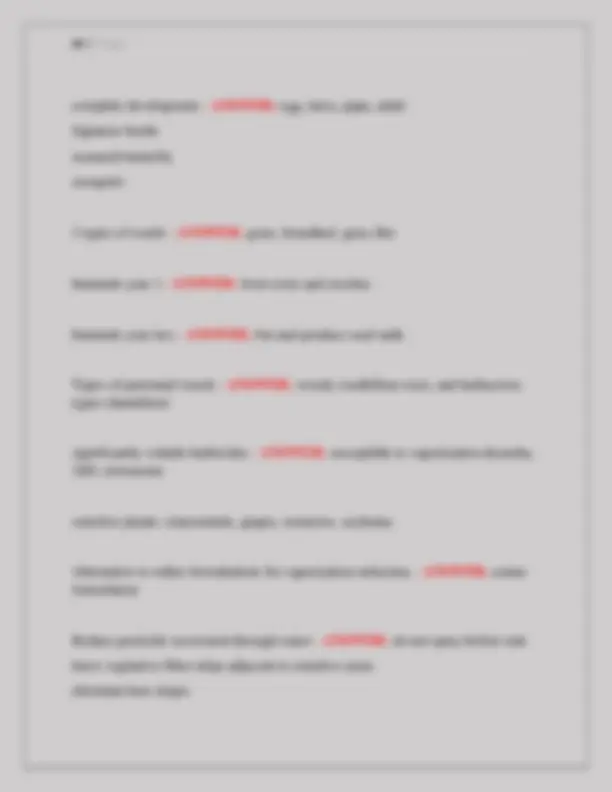
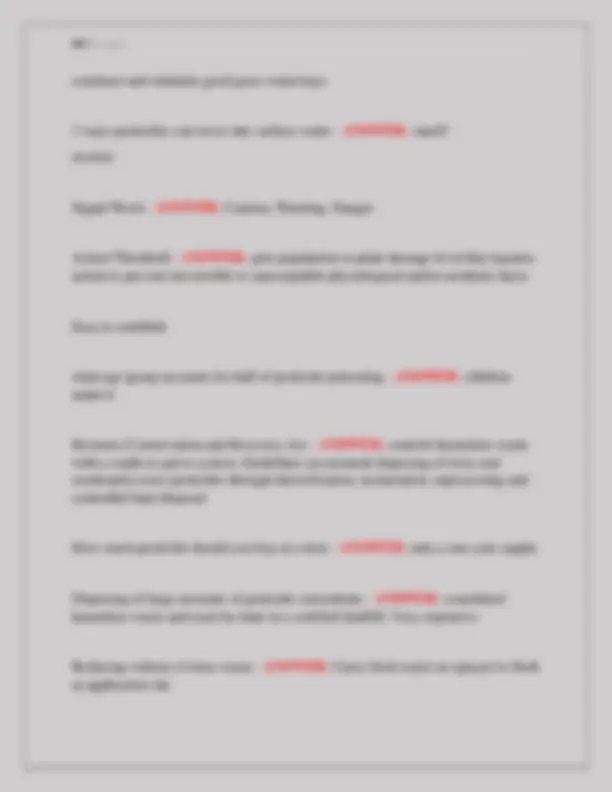
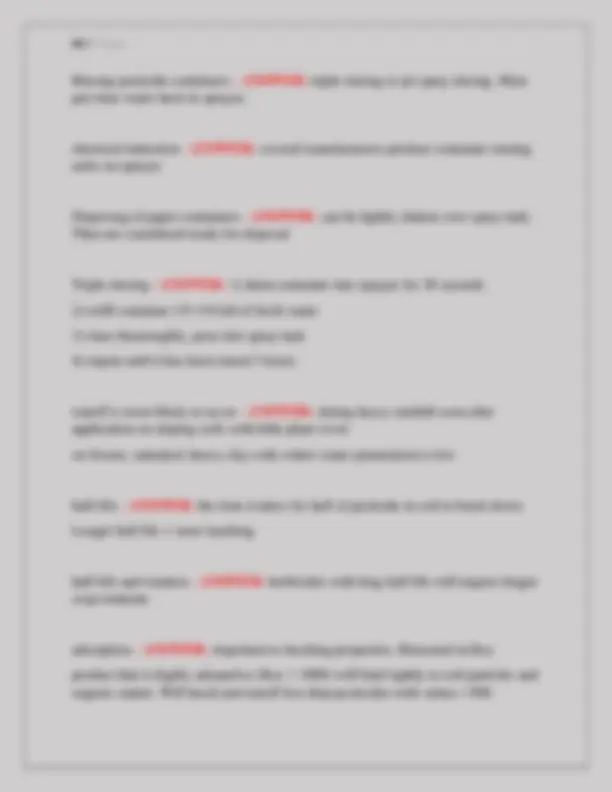
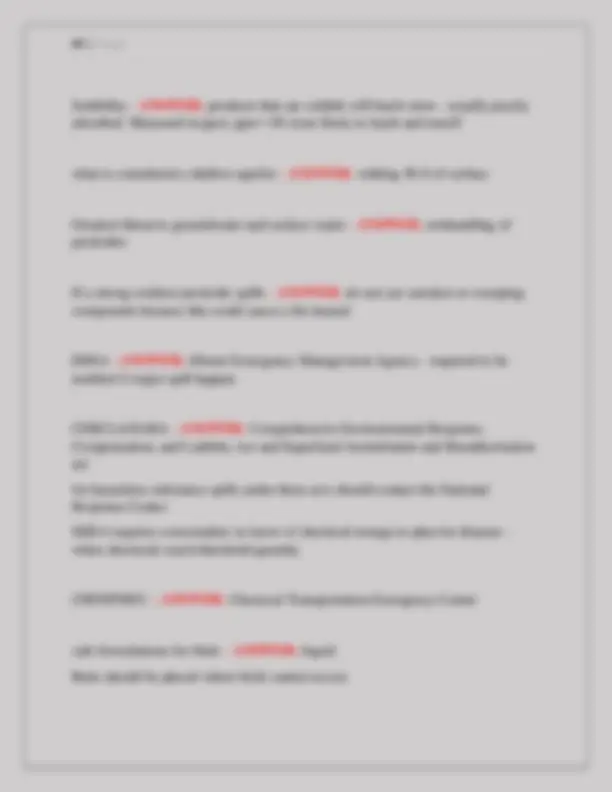
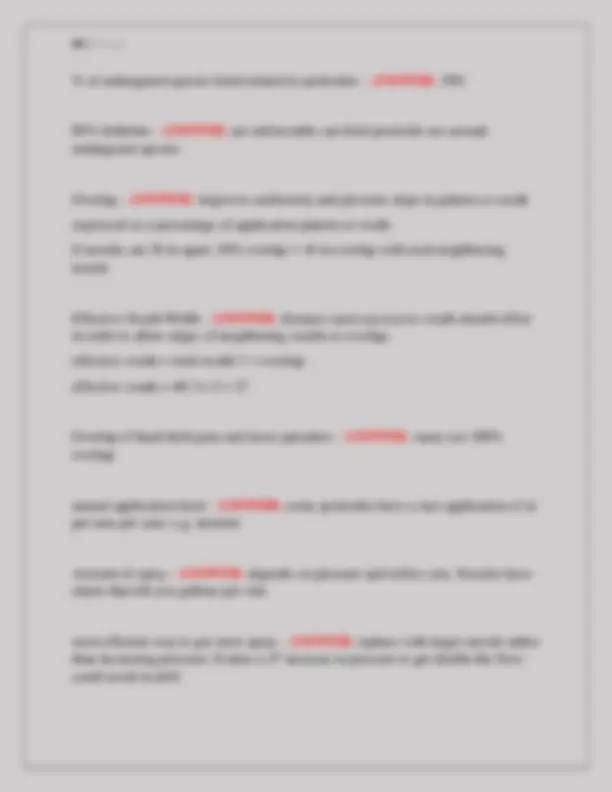
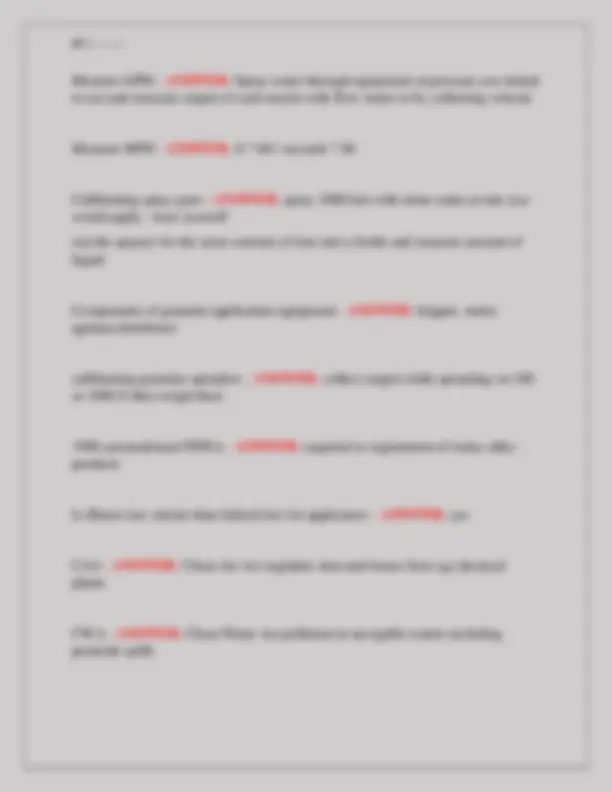
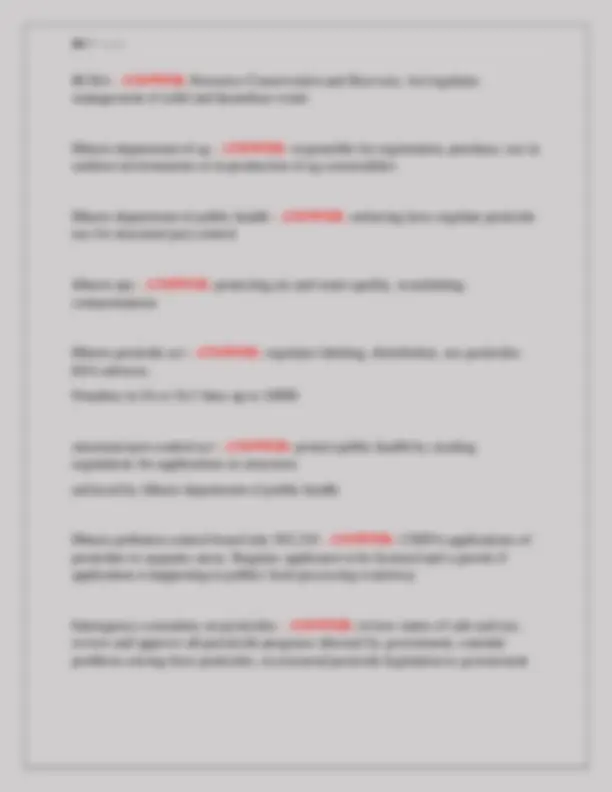
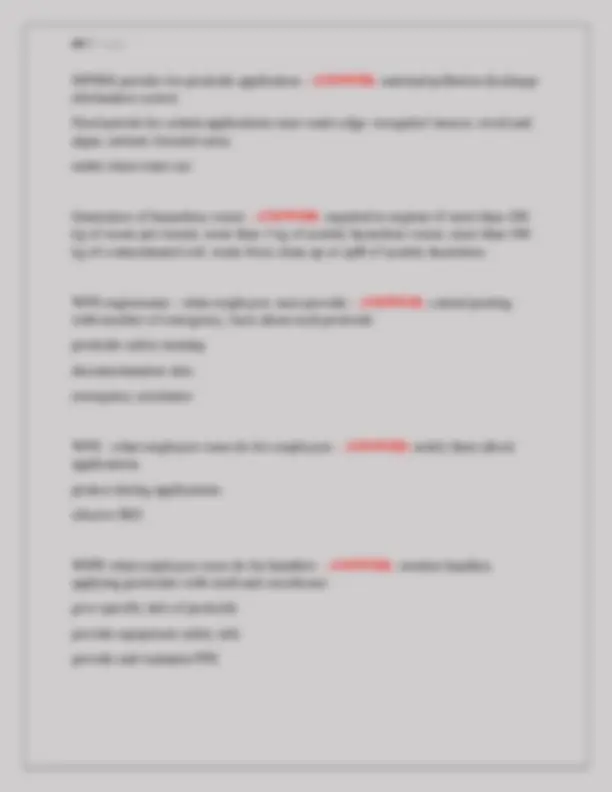


Study with the several resources on Docsity

Earn points by helping other students or get them with a premium plan


Prepare for your exams
Study with the several resources on Docsity

Earn points to download
Earn points by helping other students or get them with a premium plan
Community
Ask the community for help and clear up your study doubts
Discover the best universities in your country according to Docsity users
Free resources
Download our free guides on studying techniques, anxiety management strategies, and thesis advice from Docsity tutors
ILLINOIS PESTICIDE APPLICATOR EXAM|| ACTUAL EXAM ALL QUESTIONS AND 100% CORRECT ANSWERS ALREADY GRADED A+|| LATEST AND COMPLETE UPDATE 2024- 2025 WITH EXPERT VERIFIED SOLUTIONS|| ASSURED PASS!!!
Typology: Exams
1 / 29

This page cannot be seen from the preview
Don't miss anything!






















What is a pesticide - ANSWER: a substance used for destroying insects or other organisms harmful to cultivated plants or to animals. Pesticides are made up of - ANSWER: Active and inert ingredients AI - ANSWER: Active ingredient - chemical effective against pest Inert ingredients - ANSWER: don't harm pest but make the AI more effective Herbicide formulation - ANSWER: may be ready to use or may require dilution with carrier (oil or liquid) 60WDG - ANSWER: 60% AI water-dispersible granule 4EC - ANSWER: 4 lbs ai per gallon of emulsifiable concentrate SP - ANSWER: Soluable powder - dry formulation. Mixed with water. Dissolve readily and form true solution.
WP, P - ANSWER: Wettable Powder - dry formulation. Finely ground powder. Forms suspension not true solution. Abrasive, requires agitation, inhalation risk DF, WDG - ANSWER: Dry flowables or water dispersible granules - dry formulation. Similar to WP except AI is in granule instead of powder form suspension. Less dust than WP G - ANSWER: Granules - dry formulation. AI coated with clay, newspaper Applied directly, no mixing Low hazzard to applicators P, PS - ANSWER: Pellets - dry formulation. Same as granules but larger D - ANSWER: Dusts - dry formulations. Low percentage of AI on very fine carrier (talk, chalk, clay) Most ready to use (no mixing) Inhilation hazard Drift hazzard (uncommon use) EC - ANSWER: Emulsifiable concentrate - wet formulation. AI mixed with 1+ solvents and emulsifier that allows mixing with water Easily absorbed through skin (dermal hazzard) ME - ANSWER: Microencapsulated - wet formulation AI is surrounded by plastic coating suspended in liquid
utility adjuvants - ANSWER: defoamer, water conditioner (acids) Drift reduction additives - ANSWER: thickening agents increase droplet size Droplets must be over 200 microns Sticker - ANSWER: increase adherence of chemical to surface Surfactant, Spreaders - ANSWER: Spread spray mix more thoroughly Decreases surface tension of water Penetrants - ANSWER: helps pass through outer surface of plants - through waxy coating on leaves (cuticle) Defoaming agents - ANSWER: eliminate foam from spray tanks (especially during agitation) Mixing of pesticides - ANSWER: ensure that pesticides retain properties when you mix Do not change toxicity or physical properties when combined Illegal to mix pesticides with products prohibited on label Chemical incompatibility - ANSWER: antagonism: decrease effectiveness Synergism: increase effectiveness (can be bad) *cannot tell if chemically incompatible by mixing alone physical incompatibility - ANSWER: pesticides don't mix properly
Curdling, gel formation, sludge Perform jar compatibility test Proper mixing order - ANSWER: 1) fill tank 1/4-1/2 full of carrier and agitate
label - hazard statement - ANSWER: volunteers can only apply herbicides labeled as caution label - manufacturer contact info - ANSWER: Incase of emergency label - general info - ANSWER: basic info on how pesticide works and how long it takes to see effects, what conditions to treat Label - cautionary statements - ANSWER: avoid unintended injury to non-targets Label - spray solution chart - ANSWER: determine amount needed for different solution strengths Label - control recommendations - ANSWER: Recommendations for control of different weeds Label - species specific control recommendations chart - ANSWER: Control recommendations for specific species Label - wetland/ aquatic info - ANSWER: if applying near water need to use product labeled for use in those areas. Specific info about this type of application label - sites specific control recommendations chart - ANSWER: specific control recommendations for certain sites (forestry, utility rights of way) Label - mixing info - ANSWER: Info about which other pesticides compatible with product, what rates to mix them, how to mix them
Label - cut stump treatments - ANSWER: specific info for this type of application What warning is on every pesticide label - ANSWER: Keep out of reach of children Toxicity - ANSWER: ability to cause damage and death LD 50 - ANSWER: the amount of a chemical that kills 50% of the animals in a test population Exposure - ANSWER: how pesticides enter body reason to wear ppe Routes of exposure - ANSWER: oral, dermal, eye, inhalation acute exposure - ANSWER: one-time sever contact. Spilling on clothes/ skin Ingesting Never work alone with toxic chemicals Organophosphates and carbamates - ANSWER: Organophosphates involved in more cases of poisoning than any other insecticide Detecting organophospgate and carbamate poisoning - ANSWER: blood cholinesterase test. Reductions in cholinesterase indicates poisoning Chronic effects - ANSWER: long term low-level exposure
PPE during mixing - ANSWER: boots, gloves, apron, goggles
Pesticide mixing and loading - ANSWER: filling, rinsing, draining equipment should have wash pad, wash rack or concrete apron with well designated sump to catch contaminated water small amounts can be diluted and re-applied Do not exceed label rates on area Pesticide container rinsing - ANSWER: at end of day - add to tank and spray remaining herbicide on target plants triple rinse, still have residue Tank/ backpack rinsing - ANSWER: some oil formulations (24D) may leave residues that can cause harm to plants Use household ammonia to rinse oily residue Particle drift - ANSWER: spray particles move usually by wind Prevent drift - ANSWER: Dont spray when: winds over 10MPH, winds shifty, winds blowing towards sensitive areas, during periods of calm/ inversions Vapor drift - ANSWER: formed after application carried out of target area (volitization) can occur up to several days after some products if used in hot weather Factors increase drift - ANSWER: droplet size under 200 microns wind/ air currents
4 factors determine if pesticides reach groundwater - ANSWER: 1) properties of pesticide: persistence, adsorption, solubility
over/ alongside row of crop uniformly in band Broadcast - ANSWER: treat entire field mostly uniform throughout field Centrifugal pump - ANSWER: low pressure up to 140 psi and high volume Roller pump - ANSWER: medium pressure up to 300 psi and higher volume - not as many gallons per min as centrifugal Piston pump - ANSWER: High pressure up to 1000 psi and low flow cannot be used with abrasive formulas Hydraulic agitation - ANSWER: solution circulates through pump and back into tank to mix solution Mechanical agitation - ANSWER: uses paddles to agitate hoses - ANSWER: must be right size, strenght, material for flow, pressure and type of material Oversized hose - ANSWER: may allow pesticides to settle before sprayed undersized hose - ANSWER: restrict flow and pressure
boom sprayer height lowering - ANSWER: reduces drift and overlap Gallons per minute - ANSWER: GPM = GPA * MPH * W (width sprayed per nozzle in inches) / 5940 GPM= GPA * MPH * SW (swath width, in ft.) / 495 Gallons per acre - ANSWER: GPA = GPM * 5940 / MPH * W GPA = GPM * 485 / MPH * SW 20G - ANSWER: Granular - 20 % A.I 8EC - ANSWER: emulcifiable concentrate 8 lb ai per gallon of product Insecticide act of 1910 - ANSWER: truth in labeling act required chemical producers to label packages with the word poison Federal insecticide, fungicide and rodensticide act (FIFRA) 1947 - ANSWER: regulates use of pesticides to protect humans, wildlife, environment US EPA enforces Pesticide user assurance pesticide registration: general/ restricted use
Federal Environmental Pesticide control Act (FEPCA) 1972 ammendment - ANSWER: Amendment to FIFRA extended federal authority over pesticide manufacturing, shipment, use made label a legal document Required registration requires state laws paralleling FIFRA Classified products general and restricted use pesticides 1975 revisions fo FIFRA - ANSWER: added provisions for state enforcement misuse penalties cooperative extension services to inform and educate strengthened cirtification and restricted uses Food Quality and Protection Act FQPA - 1996 - ANSWER: Revision to FIFRA Tolerance reevaluation special provisions for infants and children endocrine disruptor testing minor use registrations right to know Office of safety and health administration (OSHA) - ANSWER: regulations for employers with 10+employees worker right to know dissemination of chemical safety info, SDS and training SDS sheets to be available to employees
protects agricultural workers and pesticide handlers facts about pesticide safety training decontamination areas with cleanup supplies Emergency assistance Record keeping requirements - ANSWER: restricted use - must keep records commercial applicators record keeping - ANSWER: record within 14 days and kept for 2 years
Disposing of containers - ANSWER: triple rinse, pressure rinse Can containers be burnedf - ANSWER: only in permitted areas GPM - ANSWER: determined by orifice size and operating pressure (psi) MPH - ANSWER: doubling speed reduces GPA by 1/ halving speed increases GPA by 2 How much do you need to increase pressure in order to double nozzle flow rate - ANSWER: increasing pressure increases flow rate in a square root relationship 4X increase in pressure for 2x flow rate Checking nozzle flow rate - ANSWER: make certain individual nozzle hasn't worn, make sure that all nozzles have same flow rate nozzle 10% above or below others should be replaced Callibrating - ANSWER: 1. spray 1000 feet uniformly